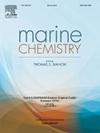西南印度洋塞舌尔-查戈斯温跃层脊(SCTR)颗粒有机质垂直生化组成
IF 2.5
3区 地球科学
Q2 CHEMISTRY, MULTIDISCIPLINARY
引用次数: 0
摘要
与邻近的非塞舌尔-查戈斯温跃层脊区相比,西南印度洋塞舌尔-查戈斯温跃层脊区具有上升流驱动的营养物质富集和生物活性增强的特征。本研究研究了不同环境下颗粒物有机质(POM)的垂直分布和生化组成。SCTR具有较浅的温跃层和较低的海面温度,表明上升流,这与叶绿素-a浓度显著升高相关(t检验,p <;0.05)。微细浮游植物在SCTR中占明显优势,占总浮游植物生物量的13.6±3.0%,而在非SCTR中为5.6±1.6%。CHEMTAX分析揭示了不同的浮游植物群落,硅藻在SCTR中的丰度(16.5±4.5%)大约是非SCTR的4倍(4.2±1.2%)。原绿球藻在两个区域均占主导地位,但在SCTR中所占比例(25.2±3.9%)低于非SCTR(46.8±7.1%)。POM的生物大分子组成存在明显的区域差异,SCTR光化学层的脂质浓度(61.3 μg L−1)显著高于非SCTR光化学层(23.4 μ L−1)。SCTR光区生物大分子总浓度(96.3 μg L−1 vs. 40.9 μg L−1)是非SCTR光区生物大分子浓度的两倍多,反映出生物生产力的增强。在SCTR的凋亡层中也检测到大分子浓度升高。值得注意的是,SCTR中从光层到光层的蛋白质与碳水化合物比率下降不太明显,这表明该地区下沉到深海的POM相对较新鲜,降解程度较低,表明生物碳泵更有效,碳固存潜力增强。这些发现强调了SCTR是生物生产力提高和驱动生物地球化学循环的独特环境机制的关键区域,为热带上升流系统的有机质保存和碳输出过程及其在全球海洋生态系统中的作用提供了重要见解。本文章由计算机程序翻译,如有差异,请以英文原文为准。
Vertical biochemical composition of particulate organic matter in the Seychelles-Chagos Thermocline Ridge (SCTR), southwestern Indian Ocean
The Seychelles-Chagos Thermocline Ridge (SCTR) in the southwestern Indian Ocean is characterized by upwelling-driven nutrient enrichment and enhanced biological activity compared to adjacent non-SCTR regions. This study investigated the vertical distribution and biochemical composition of particulate organic matter (POM) within these contrasting environments. The SCTR featured a shallower thermocline and cooler sea surface temperatures, indicative of upwelling, which correlated with significantly higher chlorophyll-a concentrations (t-test, p < 0.05). A notable dominance of micro-sized phytoplankton was observed in the SCTR, contributing 13.6 ± 3.0 % of the total phytoplankton biomass, compared to 5.6 ± 1.6 % in the non-SCTR. CHEMTAX analysis revealed distinct phytoplankton communities, with diatoms being approximately four times more abundant in the SCTR (16.5 ± 4.5 %) than in the non-SCTR (4.2 ± 1.2 %). Meanwhile, Prochlorococcus dominated both regions but contributed less in the SCTR (25.2 ± 3.9 %) than non-SCTR (46.8 ± 7.1 %). The biological macromolecular composition of POM showed clear regional differences, with lipid concentrations in the SCTR's photic layer significantly higher (61.3 μg L−1) than in the non-SCTR (23.4 μg L−1). Total biological macromolecule concentrations in the SCTR's photic zone was more than double that of the non-SCTR (96.3 μg L−1 vs. 40.9 μg L−1), reflecting enhanced biological productivity. Elevated macromolecule concentrations were also detected in the aphotic layer of the SCTR. Notably, the less pronounced decline in the protein-to-carbohydrate ratio from photic to aphotic layers in the SCTR suggests that POM sinking to the deep ocean in this region is relatively fresher and less degraded, indicating a more efficient biological carbon pump and enhanced potential for carbon sequestration. These findings highlight the SCTR as a key region of elevated biological productivity and distinct environmental mechanisms driving biogeochemical cycling, providing critical insights into organic matter preservation and carbon export processes in tropical upwelling systems and their role in global marine ecosystems.
求助全文
通过发布文献求助,成功后即可免费获取论文全文。
去求助
来源期刊

Marine Chemistry
化学-海洋学
CiteScore
6.00
自引率
3.30%
发文量
70
审稿时长
4.5 months
期刊介绍:
Marine Chemistry is an international medium for the publication of original studies and occasional reviews in the field of chemistry in the marine environment, with emphasis on the dynamic approach. The journal endeavours to cover all aspects, from chemical processes to theoretical and experimental work, and, by providing a central channel of communication, to speed the flow of information in this relatively new and rapidly expanding discipline.
 求助内容:
求助内容: 应助结果提醒方式:
应助结果提醒方式:


